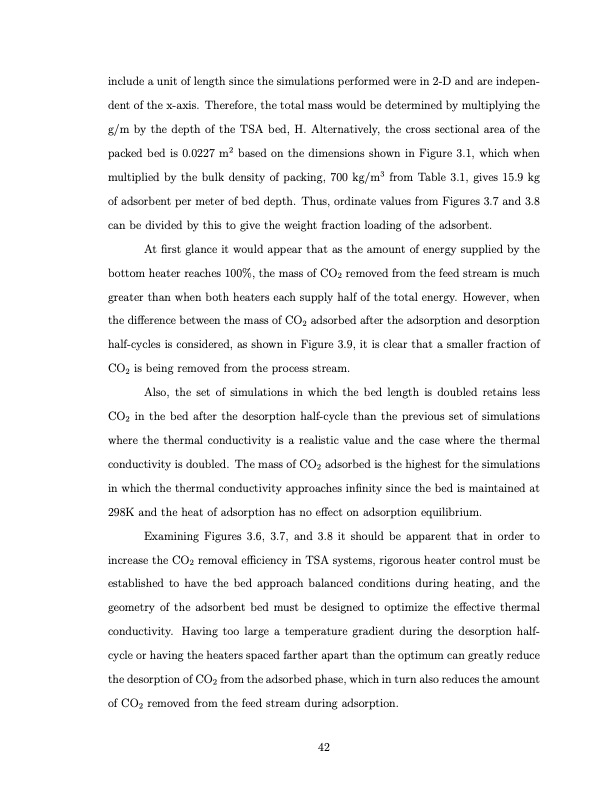
PDF Publication Title:
Text from PDF Page: 054
include a unit of length since the simulations performed were in 2-D and are indepen- dent of the x-axis. Therefore, the total mass would be determined by multiplying the g/m by the depth of the TSA bed, H. Alternatively, the cross sectional area of the packed bed is 0.0227 m2 based on the dimensions shown in Figure 3.1, which when multiplied by the bulk density of packing, 700 kg/m3 from Table 3.1, gives 15.9 kg of adsorbent per meter of bed depth. Thus, ordinate values from Figures 3.7 and 3.8 can be divided by this to give the weight fraction loading of the adsorbent. At first glance it would appear that as the amount of energy supplied by the bottom heater reaches 100%, the mass of CO2 removed from the feed stream is much greater than when both heaters each supply half of the total energy. However, when the difference between the mass of CO2 adsorbed after the adsorption and desorption half-cycles is considered, as shown in Figure 3.9, it is clear that a smaller fraction of CO2 is being removed from the process stream. Also, the set of simulations in which the bed length is doubled retains less CO2 in the bed after the desorption half-cycle than the previous set of simulations where the thermal conductivity is a realistic value and the case where the thermal conductivity is doubled. The mass of CO2 adsorbed is the highest for the simulations in which the thermal conductivity approaches infinity since the bed is maintained at 298K and the heat of adsorption has no effect on adsorption equilibrium. Examining Figures 3.6, 3.7, and 3.8 it should be apparent that in order to increase the CO2 removal efficiency in TSA systems, rigorous heater control must be established to have the bed approach balanced conditions during heating, and the geometry of the adsorbent bed must be designed to optimize the effective thermal conductivity. Having too large a temperature gradient during the desorption half- cycle or having the heaters spaced farther apart than the optimum can greatly reduce the desorption of CO2 from the adsorbed phase, which in turn also reduces the amount of CO2 removed from the feed stream during adsorption. 42PDF Image | TEMPERATURE SWING ADSORPTION COMPRESSION AND MEMBRANE SEPARATIONS

PDF Search Title:
TEMPERATURE SWING ADSORPTION COMPRESSION AND MEMBRANE SEPARATIONSOriginal File Name Searched:
temp-swing-adsorption.pdfDIY PDF Search: Google It | Yahoo | Bing
CO2 Organic Rankine Cycle Experimenter Platform The supercritical CO2 phase change system is both a heat pump and organic rankine cycle which can be used for those purposes and as a supercritical extractor for advanced subcritical and supercritical extraction technology. Uses include producing nanoparticles, precious metal CO2 extraction, lithium battery recycling, and other applications... More Info
Heat Pumps CO2 ORC Heat Pump System Platform More Info
| CONTACT TEL: 608-238-6001 Email: greg@infinityturbine.com | RSS | AMP |